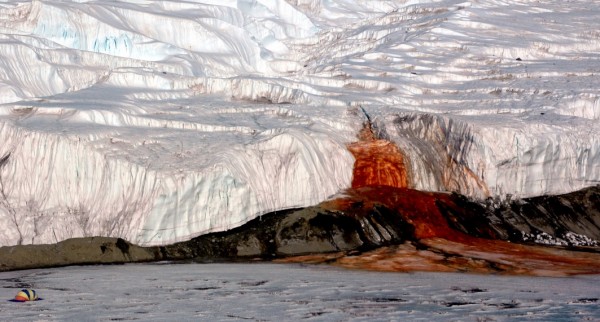Antarctica's 'Blood Glacier' Can Host Primitive Alien Life Forms
| Ana Verayo | | Apr 29, 2015 07:13 AM EDT |
(Photo : Wikimedia) Found in Taylor Glacier, Blood Falls gushes out brine rich in iron and sulfur into the Antarctic.
The bizarre Blood Falls in Antarctica gushes out dark red, iron rich sediments where researchers believe that this glacier can be host to micro organisms similar to microbial alien life that can be found on Mars and other alien worlds.
Apparently, a salty layer of permeable rock network was detected underneath this bleeding glacier, some 1,150 feet below the surface of the McMurdo Dry Valleys. What's more surprising is that this barren region measuring 7.5 miles from inland to the coast is the driest and coldest desert on the planet and it is also ice free.
Like Us on Facebook
Scientists observed and examined these features via an electromagnetic sensor hovering above the area that is carried by a helicopter.This magnetic coil detector was able to determine the presence of flowing salty lakes underneath the frozen surface.
This network of salty lakes is presumed to be home to ancient yet hardy microbes that are thriving on one of the most inhospitable places on Earth. Scientists believe that these primitive life forms can be similar to those that still might exist below the frozen desert in Mars.
According to Jill Mikucki from the University of Tennessee, this could change what people understand about the coastal margins in Antarctica. This siginificant sediment that is saturated under the surface of this glacier is now seeping into the ocean that can affect the ocean food webs. This can lead to better understanding how this flow of nutrients can affect the health of an ecosystem.
Biologists are eager to study how these micro organisms can thrive in salty lakes and adapt in one of the most lifeless regions on the planet. This can also lead to the better understanding of signs of life in this type of environment in order to recognize and determine alien life that could still exist on Mars.
The high concentration of salt could be the key as how this primitive life forms continue to exist in a system since it keeps the water from freezing. Scientists believe that a similar process can help alien life thrive in the dry deserts on the surface of Mars.
Blood Falls is found in Taylor Glacier where scientists have investigated this feature more than any glacier in the world. The falls is seeping with brine which is rich in iron that gives a blood hued appearance over its subsurface. This hotspot of mircrobial life feeds on sulfur and iron which are known to emerge from the geological feature.
This unique method using a magnetic coil to detect and identify underground salty lakes were developed by scientists from the University of Aarhus in Denmark where this marks the first time that the technique was used in Antarctica.
This study is published in the journal Nature Communications.
Tagstaylor glacier, blood falls, Antarctica, primitive life forms mars, blood falls glacier antarctica primitive life forms, Mars, McMurdo Dry Valleys
©2015 Chinatopix All rights reserved. Do not reproduce without permission
EDITOR'S PICKS
-

Did the Trump administration just announce plans for a trade war with ‘hostile’ China and Russia?
-

US Senate passes Taiwan travel bill slammed by China
-

As Yan Sihong’s family grieves, here are other Chinese students who went missing abroad. Some have never been found
-

Beijing blasts Western critics who ‘smear China’ with the term sharp power
-

China Envoy Seeks to Defuse Tensions With U.S. as a Trade War Brews
-

Singapore's Deputy PM Provides Bitcoin Vote of Confidence Amid China's Blanket Bans
-

China warns investors over risks in overseas virtual currency trading
-

Chinese government most trustworthy: survey
-

Kashima Antlers On Course For Back-To-Back Titles
MOST POPULAR
LATEST NEWS
Zhou Yongkang: China's Former Security Chief Sentenced to Life in Prison

China's former Chief of the Ministry of Public Security, Zhou Yongkang, has been given a life sentence after he was found guilty of abusing his office, bribery and deliberately ... Full Article
TRENDING STORY

China Pork Prices Expected to Stabilize As The Supplies Recover

Elephone P9000 Smartphone is now on Sale on Amazon India

There's a Big Chance Cliffhangers Won't Still Be Resolved When Grey's Anatomy Season 13 Returns

Supreme Court Ruled on Samsung vs Apple Dispute for Patent Infringement

Microsoft Surface Pro 5 Rumors and Release Date: What is the Latest?










